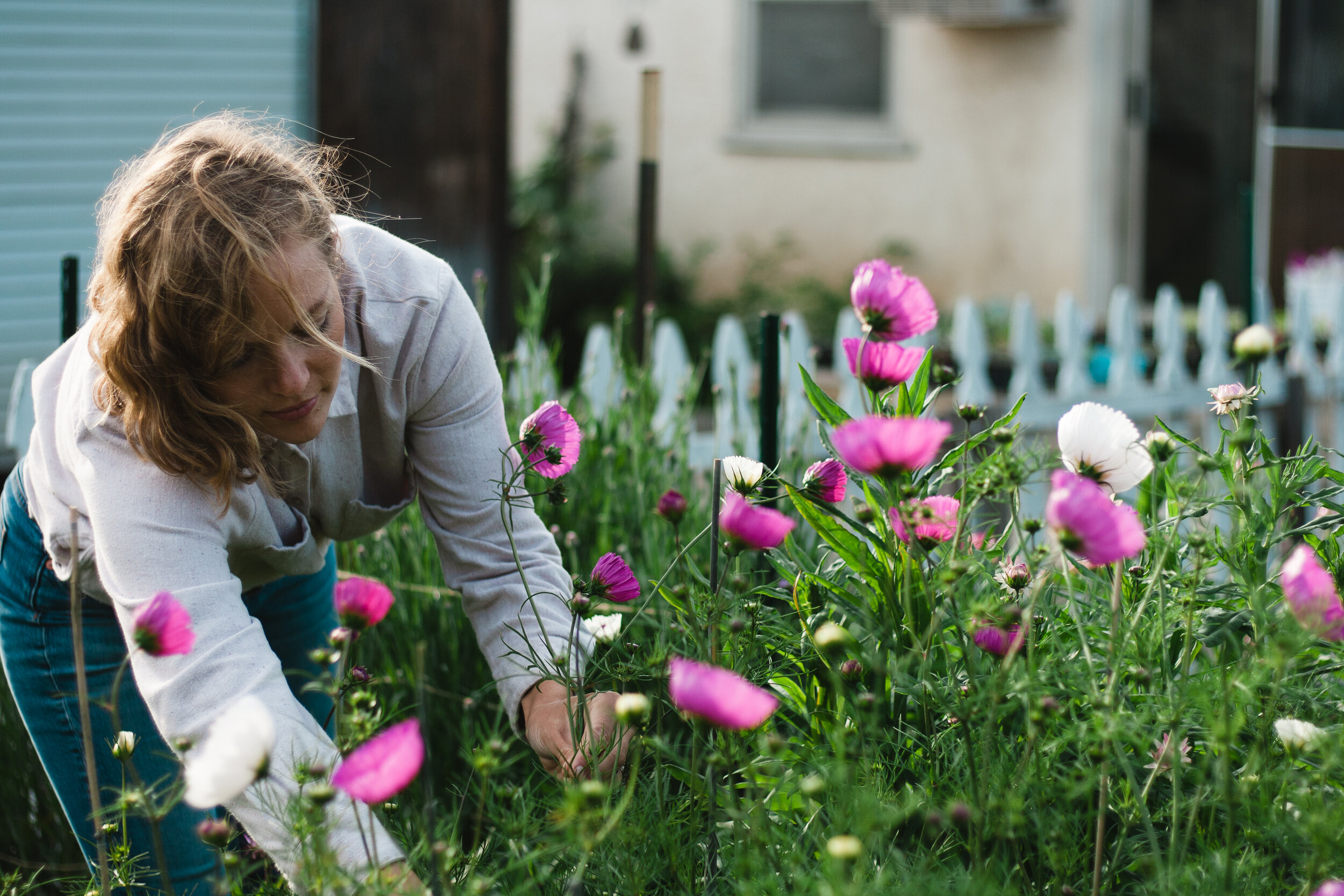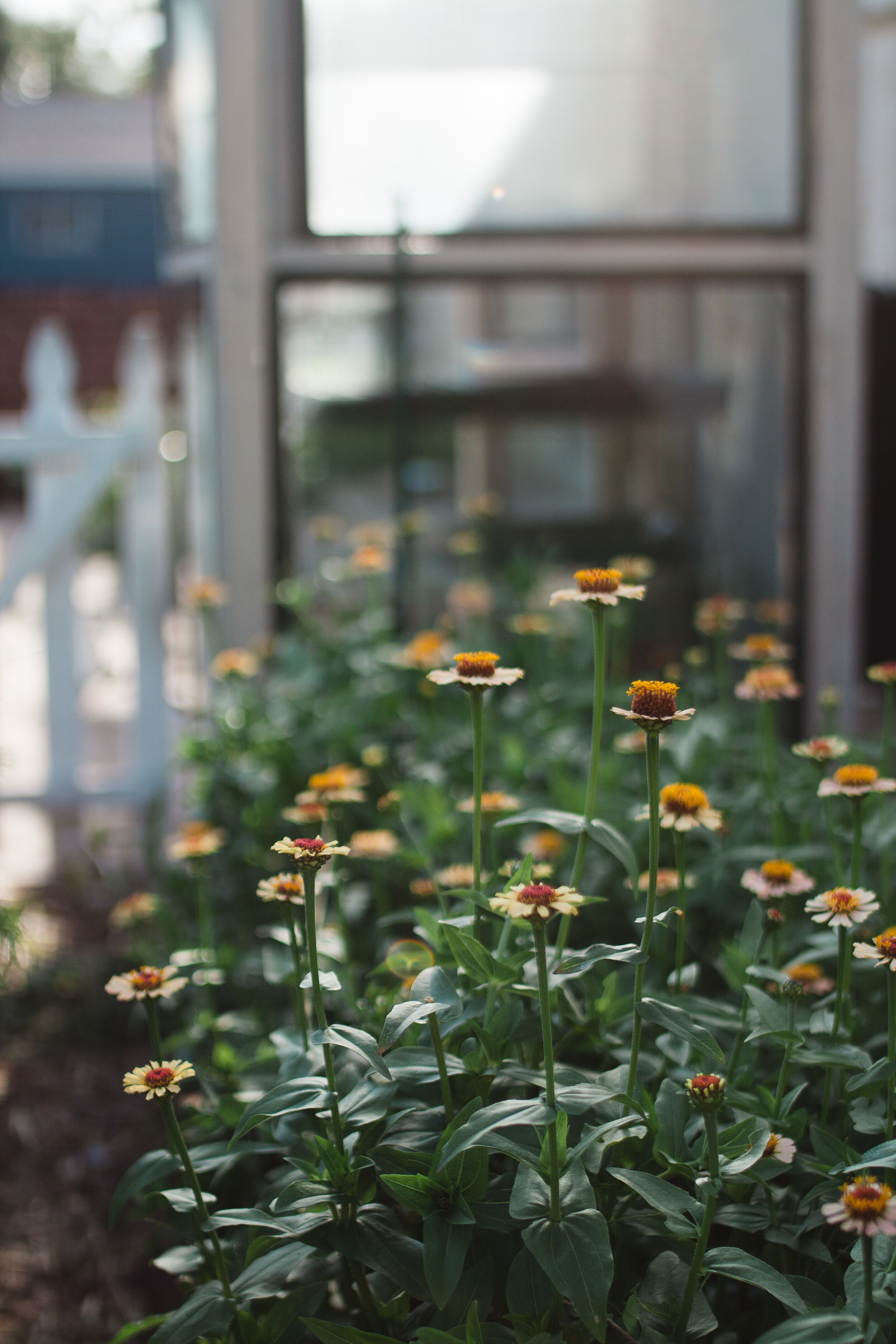Creative Ways to Grow a Productive Cutting Garden in a City
Are you wondering if you can grow a substantial amount of flowers in an urban environment? Growing a cutting garden—and even running a micro flower farm—while city-living is not only possible, but beautiful.
In this article, I’ll share a bit about our unique experience in starting a flower farm in the city and tips on how you can do so yourself.
Starting a Micro Flower Farm with a Unique Set Up
In 2013, we moved back to inner-city San Diego from a 40-acre ranch in rural Jamul, California, where we were running a small vegetable CSA and living as caretakers. I was pregnant with our first child and anxious to get my hands in the dirt again.
At this time, our backyard was hard-packed decomposed granite—but it was also full of promise because it was large by San Diego standards. Before we had even unpacked all of our boxes, we began adding ample amounts of locally sourced compost, animal manures, and wood chips “lasagna-layering style” to transform our blighted soil into a productive home garden. We were home.
I can’t explain it, but my draw to the garden runs deep. Fast forward seven years, and I’ve pivoted to growing specialty cut flowers for wedding florists, a colorful seasonal bouquet CSA, and two brick-and-mortar flower shops. I’ve found my way back to farming, except our “farm” looks vastly different than most.
Our micro-urban flower farm is unique because it extends into our backyard, down the alley behind our house, and out into our neighborhood via our neighbors’ yards. In each of these locations, we transformed weeds into a garden using truckloads of organic matter and a lot of grit. With the help of a greenhouse made of reclaimed windows, fertile soil, and tight plant spacing, we produce a lot of flowers in our limited growing space.
If you’re interested in growing and selling flowers for market—no matter the size of your growing space—check out our online flower growing classes!
Creativity, ingenuity, and innovation thrive under constraints. I’m not sure I would have found my way to flower farming if it weren’t for the pressure of living in the city.
For me, this has meant cobbling together enough land for a tiny farm by way of yard-sharing. If you’re flowering in the city and desire to grow a cutting-garden of your own but have no access to land, open your eyes to the possibilities. There is vacant urban land and neglected yard space just waiting to be transformed into beautiful urban gardens everywhere you look. Our cities aren’t just a place for asphalt, concrete, and advertising, but a place for gardens.
Why Grow and Sell Flowers Locally
Local flowers are superior because they last longer, smell better, and are usually produced on diverse farms using natural, sustainable farming methods that heal the land versus destroying it. With a planet actively warming and 80% of flowers packaged and shipped from outside North America, what we need is more urbanites and florists donning their comfortable work clothes and taking up growing flowers.
Imagine if you could incorporate unique product from your own garden into your bouquets, centerpieces, and installations. Locally grown flowers are better for the earth and carry with them a story, which your clients will love.
Important Considerations when Planning a Garden in the City
Location
What direction is the plot facing? Observe it on a sunny day and after heavy rain (if it rains where you live).
South-facing with at least 6 hours of full sun and adequate soil drainage is best.
Accessibility
To transform a patch of land into a budding garden, you’ll need lots of compost. Best to have nearby loading access for a pick-up truck—slogging materials, tools, and heavy buckets of flowers long distances isn’t ideal.
Availability of Water
Who will pay for water? This is an especially important question if you’re yard-sharing, using a community space, or utilize other unique farming operations.
Is there existing irrigation to tap into? Heavy use of mulches like straw and shredded leaves can decrease the frequency in which a plot needs to be irrigated.
Community
How will you leverage borrowed land? An offer to provide free yard maintenance by way of growing a garden is one idea. Or offer to share fresh flowers whenever you have them!
You might be surprised at the positive response you get if you summon your courage and ask; I know I was.
Soil Preparation
The easiest and most environmentally friendly way to prepare a new garden site for growing is using no-till techniques versus tillage. (Check out this post on the why and how of no-till flower farming).
Occultation is one way to prepare a garden bed without tilling. Cover the weedy soil with a tarp, weed mat, or cardboard for 3-6 weeks. Pull the barrier back to discover the weeds have been smothered and died. Rake away any dead plant matter, gently loosen the soil (I use a pitchfork), add a deep layer of compost, incorporate any soil amendments, and level the garden bed. Then, plant!
Growing Healthy Transplants
A small seed starting operation for growing healthy transplants is key to the productivity of a small-space cutting garden. Every time a garden bed opens up, envision yourself filling the space with sizeable transplants that same day. Transplanting (versus direct-seeding) ensures that every available growing space is being utilized.
My Favorite Flowers for a Cutting Garden in the City
Spring
Sweet pea – Lathyrus odoratus
Ranunculus - Ranunculus asiaticus
Pot Marigold - Calendula officinalis
Nigella – Nigella
Corn Cockle – Agrostemma githago
Snapdragon - Antirrhinum majus
Strawflower – Bracteantha bracteata
Ammi - Ammi visnaga and Ammi majus
Scabiosa/Pincushion Flower - Scabiosa atropurpurea
Summer/Fall
Phlox - Phlox drummondii
Cosmos - Cosmos bipinnatus
Zinnia - Zinnia elegans
Black-Eyed Susan - Rudbeckia hirta
Dahlia - Dahlia
Marigold - Tagetes erecta
Amaranth - Amaranthus
Basil - Ocimum basilicum
In early spring, you’ll find our rooftop bees abuzz and an abundance of hardy annual flowers in full bloom. My children dig in the dirt for snails and grubs to feed to our chickens, while I transplant into tidy permanent flower beds or fill custom flower orders. You can say we have the best of both worlds—working in harmony with the natural world, all while living in an exciting city.
Don’t strive for perfection. You’ll have years for future garden iterations and to improve your technique. Just begin.












